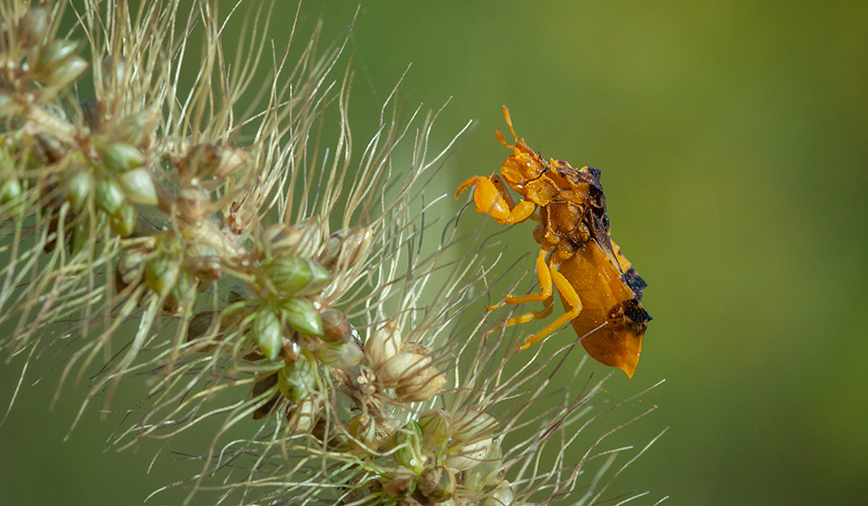“Whoops!”
That one-word exclamation was all I could muster when I realized what I’d done.
The mistake, though small by human measures, was of great magnitude for my young charges—a whole bunch of bouncing baby eastern lubber grasshoppers. Over the past few days I’d seen them through eclosion—the fancy word for hatching—and had watched protectively as they’d shed their first exoskeletons, eaten their first solid food, and taken their first hops.
Oh sure, we’d had a few bumps along the way. I accidentally squished one with a book. And I’d had to rescue three others that got stuck on some tape on the lid of their enclosure. But by and large we were about to declare our latest attempt at grasshopper-rearing a success.
Then it happened.
Or, rather, HE happened.
Like a scary clown at the edge of a playground, an ambush bug of the genus Phymata appeared, seemingly out of nowhere.
Bugs don’t have lips so they can’t smile, but if they did, I’m sure this guy would have been grinning from antenna to antenna. We found him lurking in the shadows at the bottom of the cage, the insect equivalent of a kid in a candy store or—more accurately–a fox in a henhouse.
Ambush bugs, as their name suggests, are predators that take their arthropod prey by surprise. Their intricate coloration allows them blend in amid the leaves and flowers where they lie in wait for their quarry, while enlarged forelimbs let them hold on with a powerful death grip.
Like their larger cousins the assassin bugs, they possess piercing-and-sucking mouthparts that they use to inject a potent combination of compounds that both paralyze and pre-digest the hapless prey. They then insert those same mouthparts to slurp their meal—not unlike drinking a protein shake through a straw.
Awesome, in a macabre yet wondrous way.
Frankly, I’d welcome an ambush bug just about anywhere, except the nursery tank of the grasshoppers we’ve been trying to propagate for years.
Now is as good a time as any to mention that this turn of events was completely my fault. With our prevailing mild temperatures has come an extended growth and blooming period for many of our local wildflowers. Hoping to supplement the baby lubbers’ diet of romaine lettuce, apple slices, rolled oats and dog kibble with some fresh asters—plants that also provide sturdy stalks for climbing—I’d gotten into the habit of clipping a few stems every day and placing them in the lubber tank.
A really cool caterpillar that looked an awful lot like a bird dropping came in by accident one day. Rather than taking its appearance as a warning to check for other possible hitchhikers, I instead took its picture.
If I’d chosen to examine the leaves, or looked at the seed heads a little closer, I might have realized sooner that the caterpillar wasn’t the only uninvited guest. But no, I just watched, blithely unaware, as the tiny hoppers frolicked amid the jungle gym of greenery—mere centimeters from the deadly but unseen predator.
Things could have been different, too, if the ambush bug had had a little more luck on his side. Male Phymata are distinctly smaller than females, and will often piggyback upon one and help themselves to a meal she has captured. Maybe, just maybe, I would have been able to spot a twosome (over even a threesome, as these bugs aren’t shy) hanging out on an aster bloom.
The predator may have one other wrinkle to contend with: Adult lubbers are known to exude a toxic defense chemical that’s pretty effective against vertebrate predators. I don’t know if lubber nymphs do the same nor whether ambush bugs are susceptible.
For now my plan is to wait and see what happens. I’ve got a hunch that the stronger lubbers will prevail while the weaker ones succumb to the strength and guile of little Phymata. There’s just one problem. His camouflage is so complete, I can’t find him anywhere.
Whoops.
Pam Otto is the manager of nature programs and interpretive services at the Hickory Knolls Discovery Center, a facility of the St. Charles Park District. She can be reached at 630-513-4346 or potto@stcparks.org.

